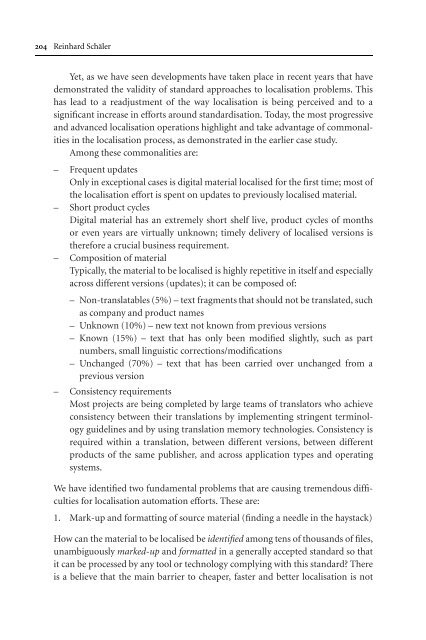Topics in Language Resources for Translation ... - ymerleksi - home
Topics in Language Resources for Translation ... - ymerleksi - home
Topics in Language Resources for Translation ... - ymerleksi - home
- No tags were found...
Create successful ePaper yourself
Turn your PDF publications into a flip-book with our unique Google optimized e-Paper software.
204 Re<strong>in</strong>hard SchälerYet, as we have seen developments have taken place <strong>in</strong> recent years that havedemonstrated the validity of standard approaches to localisation problems. Thishas lead to a readjustment of the way localisation is be<strong>in</strong>g perceived and to asignificant <strong>in</strong>crease <strong>in</strong> ef<strong>for</strong>ts around standardisation. Today, the most progressiveand advanced localisation operations highlight and take advantage of commonalities<strong>in</strong> the localisation process, as demonstrated <strong>in</strong> the earlier case study.Among these commonalities are:– Frequent updatesOnly <strong>in</strong> exceptional cases is digital material localised <strong>for</strong> the first time; most ofthe localisation ef<strong>for</strong>t is spent on updates to previously localised material.– Short productcyclesDigital material has an extremely short shelf live, product cycles of monthsor even years are virtually unknown; timely delivery of localised versions isthere<strong>for</strong>e a crucial bus<strong>in</strong>ess requirement.– Composition of materialTypically, the material to be localised is highly repetitive <strong>in</strong> itself and especiallyacross different versions (updates); it can be composed of:– Non-translatables (5%) – text fragments that should not be translated, suchas company and product names– Unknown (10%) – new text not known from previous versions– Known (15%) – text that has only been modified slightly, such as partnumbers, small l<strong>in</strong>guistic corrections/modifications– Unchanged (70%) – text that has been carried over unchanged from aprevious version– Consistency requirementsMost projects are be<strong>in</strong>g completed by large teams of translators who achieveconsistency between their translations by implement<strong>in</strong>g str<strong>in</strong>gent term<strong>in</strong>ologyguidel<strong>in</strong>es and by us<strong>in</strong>g translation memory technologies. Consistency isrequired with<strong>in</strong> a translation, between different versions, between differentproducts of the same publisher, and across application types and operat<strong>in</strong>gsystems.We have identified two fundamental problems that are caus<strong>in</strong>g tremendous difficulties<strong>for</strong> localisation automation ef<strong>for</strong>ts. These are:1. Mark-up and <strong>for</strong>matt<strong>in</strong>g of source material (f<strong>in</strong>d<strong>in</strong>g a needle <strong>in</strong> the haystack)How can the material to be localised be identified among tens of thousands of files,unambiguously marked-up and <strong>for</strong>matted <strong>in</strong> a generally accepted standard so thatit can be processed by any tool or technology comply<strong>in</strong>g with this standard? Thereis a believe that the ma<strong>in</strong> barrier to cheaper, faster and better localisation is not
















